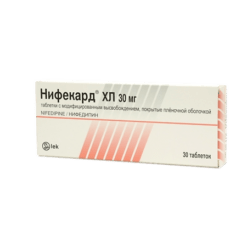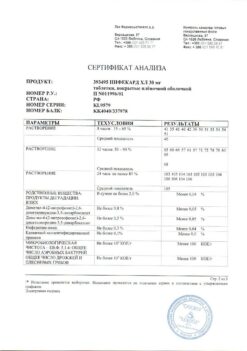No products in the cart.
Nifekard XL, 60 mg 30 pcs
€1.00
Out of stock
(E-mail when Stock is available)
Description
Nifecard XL is a hypotensive, antianginal.
Pharmacodynamics
Nifedipine is a selective blocker of “slow” calcium channels, a derivative of 1,4-dihydropyridine. It has antianginal and hypotensive effects. Reduces the flow of extracellular calcium inside cardiomyocytes and smooth muscle cells of coronary and peripheral arteries; in high doses it inhibits the release of calcium ions from intracellular depots. Reduces the number of functioning channels without affecting the time of their activation, inactivation and recovery.
Disrupts excitation and contraction processes in the myocardium mediated by tropomyosin and troponin and in vascular smooth muscle mediated by calmodulin. In therapeutic doses, it normalizes the transmembrane flow of calcium ions impaired in a number of pathological conditions, primarily in arterial hypertension. It does not affect the tone of the veins. It increases coronary blood flow, improves the blood supply to ischemic areas of the myocardium without the development of the phenomenon of bypass, activates the functioning of collaterals.
It improves myocardial function, reduces the force of heart contractions and myocardial oxygen demand. By dilating peripheral arteries, it reduces BP and decreases total peripheral resistance and afterload on the heart. Almost has no effect on the sinoauricular and atrioventricular nodes. Increases renal blood flow, causes moderate natriuresis.
Inhibits platelet aggregation, has antiatherogenic properties (especially with long-term use). Lowers the pressure in the pulmonary artery, has a positive effect on the blood supply to the brain vessels.
Pharmacokinetics
Nifecard® HL due to delayed release of active substance provides gradual controlled increase in plasma concentrations of nifedipine. The plasma concentration of nifedipine plateaus after approximately 6 h and is maintained with slight fluctuations for 24 h. Nifedipine is rapidly and almost completely absorbed after oral administration (92-98%). It is characterized by a high percentage of binding to plasma proteins (90%). T1/2 is approximately 2 h. Metabolized in the liver. No active metabolites were detected. It is excreted as inactive metabolites mainly by the kidneys (80%) and in the bile (20%).
Nifedipine penetrates through the BBB and the placental barrier and is excreted with breast milk.
There is no cumulative effect. Chronic renal failure, hemodialysis and peritoneal dialysis have no effect on pharmacokinetics. With prolonged use, development of nifedipine tolerance may be observed.
Indications
Indications
arterial hypertension; CHD: stable angina pectoris, vasospastic angina pectoris (Prinzmetal angina).
Active ingredient
Active ingredient
Composition
Composition
Active ingredient: nifedipine;
Excipients: Povidone, 75/100 mg; sodium lauryl sulfate, 2.4/4.8 mg; hypromellose, 185.8 mg (30 mg tablets); hypromellose-2906, 203.84 mg and hypromellose-2208, 123.36 mg (60 mg tablets); Ludipress® (lactose monohydrate – 93%, povidone – 3.5%, crosspovidone – 3.5%) – 70/50 mg; magnesium disilicate (talc) – 6 mg; magnesium stearate – 0.8/2 mg
Shell: Hypromellose phthalate (hydroxypropyl methylcellulose phthalate), 18.2/40 mg; triethylcitrate, 1.8/4 mg; hypromellose-2910 (hydroxypropyl methylcellulose, 3/4.5 mg; Hyprolose (hydroxypropylcellulose) – 3/4.5 mg; macrogol (polyethylene glycol) – 1/1.5 mg; magnesium disilicate (talc) – 0.5/0.75 mg; titanium dioxide – 1.93/2.9 mg; iron oxide yellow dye – 0.57/0.85 mg;
How to take, the dosage
How to take, the dosage
Ingestion, without chewing, do not crush and do not divide. The dosing regimen is set individually.
The dose of the drug Nifekard®XL is 1 tablet (30 or 60 mg) per day once. The dose is started at 30 mg/day and is corrected at 7-14 day intervals.
The maximum daily dose is 90 mg.
Interaction
Interaction
The severity of BP decrease is increased with concomitant use of other hypotensive agents, beta-adrenoblockers, nitrates, cimetidine (to a lesser extent, ranitidine), inhaled anesthetic agents, diuretics and tricyclic antidepressants.
Nifedipine causes a decrease in plasma concentrations of quinidine; after nifedipine withdrawal there may be a sharp increase in quinidine concentrations.
Enhances plasma concentrations of digoxin and theophylline; therefore, the clinical effect and plasma levels of digoxin and theophylline should be monitored.
Hepatic microsomal enzyme inducers (rifampicin, etc.) decrease nifedipine concentrations.
In combination with nitrates increases tachycardia. Sympathomimetics, NSAIDs, estrogens, calcium preparations reduce the hypotensive effect.
Nifedipine may displace drugs with high binding capacity (including indirect anticoagulants – coumarin and indandion derivatives, anticonvulsants, NSAIDs, quinine, salicylates, sulfinpyrazone) from protein binding, which may increase their plasma concentrations.
Nifedipine inhibits vincristine elimination from the body and may cause increased side effects of vincristine; if necessary, the dose of vincristine should be reduced.
Nifedipine may increase toxic effects of lithium preparations (nausea, vomiting, diarrhea, ataxia, tremor, tinnitus).
The bioavailability of cephalosporins (e.g., cefixime) and nifedipine is increased by 70% when administered concomitantly.
Grapefruit juice inhibits the metabolism of nifedipine in the body, and therefore concomitant administration is contraindicated.
Special Instructions
Special Instructions
It is recommended that treatment with Nifecard® XL be discontinued gradually. Note that angina may occur at the start of treatment, especially after recent abrupt withdrawal of beta-adrenal blockers (the latter should be withdrawn gradually).
The concomitant administration of beta-adrenal blockers should be done under close medical supervision, as this may cause excessive BP reduction and in some cases exacerbate heart failure symptoms.
The drug is dosed with great caution in severe heart failure.
The diagnostic criteria for prescribing the drug in vasospastic angina are: classic clinical presentation with ST-segment elevation, occurrence of ergonovine-induced angina or coronary artery spasm, detection of coronarospasm on angiography, or detection of an angiospastic component without confirmation (e.g., different voltage threshold or unstable angina when ECG data suggest transient angiospasm).
In patients with severe obstructive cardiomyopathy, there is a risk of increased frequency, severity and duration of angina attacks after nifedipine administration; in this case, withdrawal of the drug is necessary.
In patients on hemodialysis, with high BP and irreversible renal failure, with decreased total blood volume, the drug should be used with caution; a sharp drop in BP may occur.
Patients with impaired liver function are closely monitored and, if necessary, the dose of the drug is reduced and/or other dosage forms of nifedipine are used.
If the patient requires surgery under general anesthesia during therapy, the anesthesiologist should be informed about the nature of the therapy.
Positive results may be obtained with the direct Coombs reaction and laboratory tests for antinuclear antibodies during treatment.
Impact on psycho-emotional ability
At the time of treatment, caution should be exercised in potentially hazardous activities requiring increased concentration and rapid psychomotor reactions, and refraining from the use of ethanol.
Contraindications
Contraindications
With caution: Severe aortic or mitral valve orifice stenosis, hypertrophic obstructive cardiomyopathy, marked tachycardia, sinus node weakness syndrome, malignant arterial hypertension, myocardial infarction with left ventricular failure, unstable angina pectoris, concomitant administration of beta-adrenoblockers or cardiac glycosides, concomitant administration of rifampicin, severe circulatory disorders of the brain, hepatic and/or renal disorders, hemodialysis (risk of arterial hypotension), age under 18 years (effectiveness and safety not established).
Side effects
Side effects
System effects: excessive vasodilation (asymptomatic BP decrease, blood rush to the face, facial hyperemia, fever), tachycardia, palpitation, arrhythmia, peripheral edema, chest pain; rarely – excessive BP decrease, syncope, syncope, in some patients, especially at beginning of treatment, angina pectoris may occur, which requires drug withdrawal. Single cases of myocardial infarction have been described.
CNS disorders: headache, dizziness, fatigue, weakness, somnolence. When prolonged oral administration in high doses – paresthesias of extremities, depression, anxiety, extrapyramidal (parkinsonian) disorders (ataxia, mask-like face, shuffling gait, stiffness of hands and feet movements, tremors of hands and fingers, difficulty swallowing).
Digestive system disorders: dry mouth, decreased appetite, dyspepsia (nausea, diarrhea or constipation); rare – gingival hyperplasia (bleeding, painfulness, swelling), with prolonged use – liver disorders (intrahepatic cholestasis, increased activity of liver transaminases).
Hematopoietic organs: anemia, asymptomatic agranulocytosis, thrombocytopenia, thrombocytopenic purpura, leukopenia.
Allergic reactions: rare – skin itching, exanthema, exfoliative dermatitis, photodermatitis; very rare – autoimmune hepatitis.
Musculoskeletal system: arthritis; rarely – arthralgia, joint swelling, myalgia, cramps of the upper and lower extremities.
Urinary system disorders: increased daily diuresis, impaired renal function (in patients with renal failure).
Others: rare – difficulty in breathing, cough; very rare – visual impairment (including transient blindness at maximum nifedipine plasma concentration), gynecomastia (in elderly patients, completely disappearing after discontinuation of the drug), hyperglycemia, galactorrhea, pulmonary edema, bronchospasm, weight gain.
Overdose
Overdose
Symptoms: peripheral vasodilation with marked and possibly prolonged systemic arterial hypotension (headache, facial hyperemia, prolonged marked BP decrease, sinus node suppression, bradycardia and/or tachycardia, bradyarrhythmia).
In severe poisoning – loss of consciousness, coma.
The treatment: consists of standard procedures for elimination of the drug from the body (administration of activated charcoal, gastric lavage), restoration of stable hemodynamic parameters, careful monitoring of the heart, lungs and excretory system. Hemodialysis is ineffective due to high degree of binding to blood plasma proteins. Calcium preparations are antidotes.
The clearance of nifedipine is increased in patients with impaired liver function.
Pregnancy use
Pregnancy use
The administration of nifedipine in the second and third trimesters of pregnancy is indicated only if the expected benefit to the mother exceeds the potential risk to the fetus.
Nifedipine penetrates into breast milk; therefore, if prescribed during lactation, breastfeeding should be stopped.
Similarities
Similarities
Additional information
| Shelf life | 3 years |
|---|---|
| Conditions of storage | At a temperature not exceeding 25 °C |
| Manufacturer | Lek d.d., Slovenia |
| Medication form | controlled release tablets |
| Brand | Lek d.d. |
Other forms…
Related products
Buy Nifekard XL, 60 mg 30 pcs with delivery to USA, UK, Europe and over 120 other countries.
















